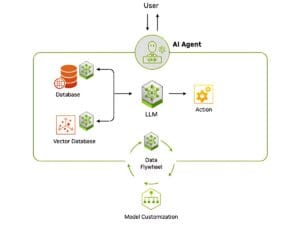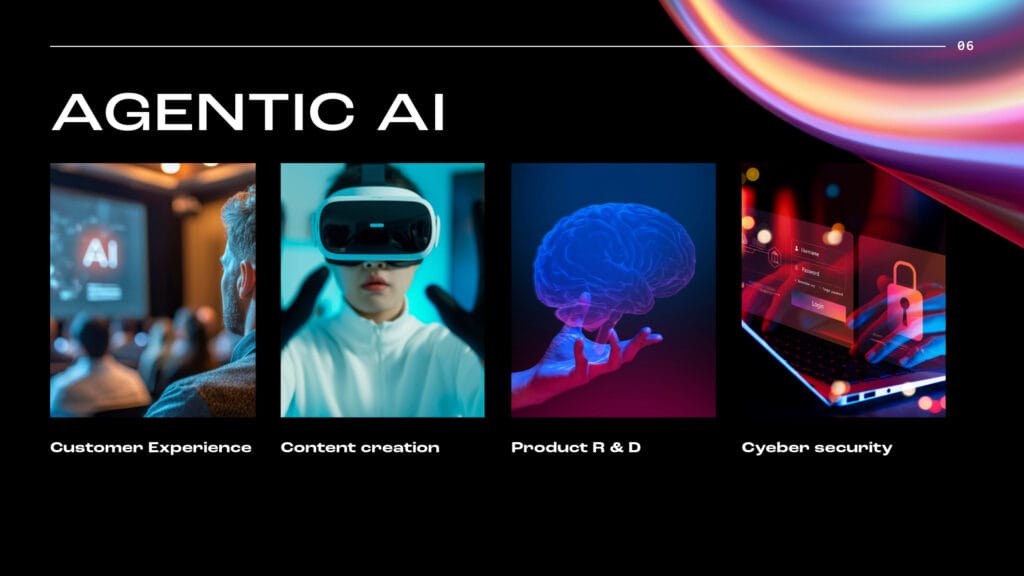Perceive: Artificial intelligence (AI) agents collect and analyze data from a variety of sources, including digital interfaces, databases, and sensors. This entails finding pertinent entities in the environment, recognizing things, or extracting important features.
Reason: A big language model serves as the reasoning engine, or orchestrator, that comprehends tasks, comes up with answers, and manages specialized models for certain activities like recommendation systems, content production, and visual processing.
In order to access private data sources and produce precise, pertinent results, this step makes use of strategies like retrieval-augmented generation (RAG).
Act: Agentic AI can swiftly carry out tasks based on the plans it has created by integrating with external tools and software through application programming interfaces.
AI agents can be equipped with guardrails to assist guarantee that they carry out duties accurately. For instance, up to a specific level, a customer care AI assistant might be able to handle claims; claims beyond that would require human approval.
Learn: A feedback loop, often known as a “data flywheel,” allows agentic AI to continuously improve by feeding the system with data produced by its interactions to improve models.
Businesses have a strong tool for improving decision-making and operational efficiency because to this capacity to adjust and grow over time.

Image – Source
Fueling Agentic AI With Enterprise Data
Generative AI is transforming businesses across industries by turning vast amounts of data into actionable insights.
This technology helps workers work more efficiently, empowering them to perform tasks with greater productivity and precision.
By making complex data easier to understand and apply, generative AI is driving innovation and improving outcomes in various job roles and sectors.
By using accelerated AI query engines to analyze, store, and retrieve data in order to improve generative AI models, AI agents expand on this potential by gaining access to a variety of data.
RAG is a crucial method for accomplishing this, enabling AI to access a wider variety of data sources.
AI agents learn and develop over time by building a data flywheel, in which interaction-generated data is pushed back into the system to refine models and boost efficacy.
Building responsive agentic AI applications requires effective data management and access, which is made possible by the end-to-end NVIDIA AI platform, which includes NVIDIA NeMo microservices.
Agentic AI in Action
Agentic AI has a wide range of possible uses, constrained only by imagination and skill. AI agents are revolutionizing a variety of industries, from straightforward jobs like creating and disseminating content to more intricate use cases like coordinating corporate software.

Customer Service
AI agents are transforming customer service by automating repetitive tasks and enhancing self-service options.
As a result, service teams are experiencing notable benefits, such as faster response times and higher customer satisfaction.
In fact, more than half of customer service workers have reported these positive changes, enabling them to provide a more seamless and efficient experience for customers.
Additionally, digital humans AI-powered agents that represent a business’s brand are gaining popularity.
These digital agents offer realistic, real-time interactions, helping sales representatives directly address consumer inquiries or issues, particularly during high call volume periods.
Content Creation
Generative AI is revolutionizing content creation by enabling the rapid production of personalized, high-quality marketing content.
By saving marketers an average of three hours per piece, AI frees them up to focus more on strategy and creativity.
This streamlined process not only boosts efficiency but also helps businesses maintain a competitive edge and foster stronger client engagement through consistent, relevant content.
Software Engineering
AI agents are automating time-consuming coding processes, significantly increasing developer productivity.
Projections suggest that by 2030, AI could automate up to 30% of work hours in the tech industry, allowing engineers to dedicate more time to solving complex problems and driving innovation.
This shift is set to enhance efficiency across the development lifecycle, ultimately advancing the capabilities of software engineering teams.
Healthcare
In healthcare, AI bots are making a powerful impact by extracting crucial information from vast patient and medical datasets.
It helps physicians make more informed treatment decisions. Moreover, by automating administrative tasks and taking clinical notes during patient consultations, AI enables doctors to focus more on building relationships with their patients.
Beyond this, AI agents also provide round-the-clock support to patients, offering medication reminders, appointment scheduling, and guidance on how to follow treatment plans, ensuring better patient compliance and care.
How To Get Started?
Agentic AI is the next wave of artificial intelligence, with the potential to transform business operations. It enhances efficiency through its ability to plan, interact with various tools, and seamlessly integrate with software ecosystems.
NVIDIA NIM Agent Blueprints provide reference code, sample data, tools, documentation, and sample applications to accelerate the deployment of generative AI-powered applications and agents. These blueprints enable businesses to streamline their AI adoption process with ease.
With solutions built using NIM Agent Blueprints, NVIDIA partners like Accenture are helping enterprises unlock the full potential of agentic AI. Additionally, companies exploring advancements in AI, such as DeepSeek-AI, continue to push the boundaries of intelligent automation, further shaping the future of AI-driven business solutions.
Feature Image – source
